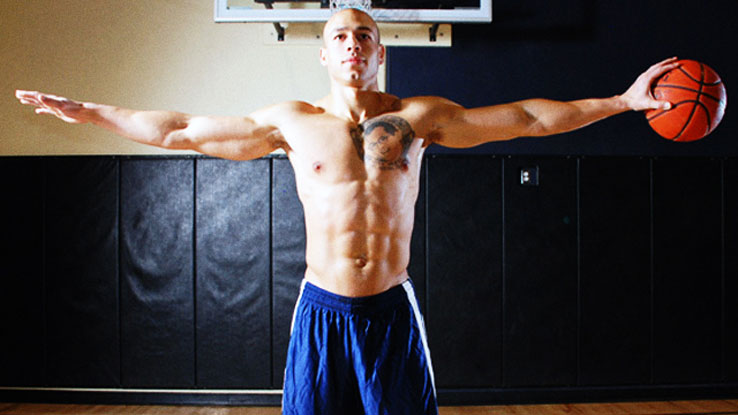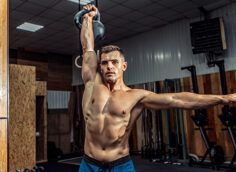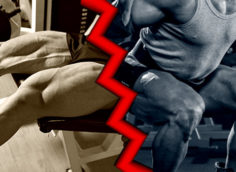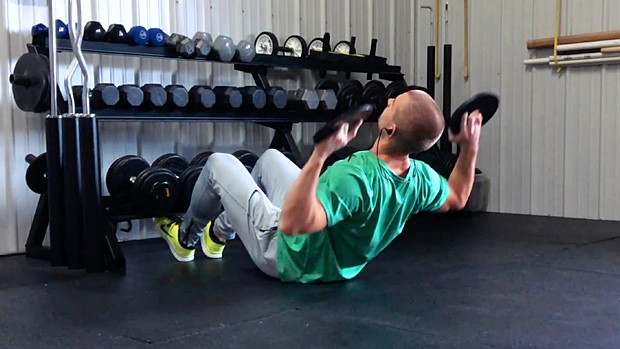The one thing I hated the most when I was growing up was when people would look at me and only acknoweldge one thing:
"Whoa, that guy's tall!"
It was the one adjective I wanted people to avoid when describing me. In my eyes, it was more pejorative than calling me straight up stupid.
I was a teenager, well over 6 feet tall, trying hard in the gym to change my image from being the "tall guy" to being the "big guy." And it wasn't working. Over the last few years, it's made for a few experiences, which led to smarter training, and a slightly jaded perspective towards lifting as a tall athlete. Knowing this, it's about time we all cut the crap.
In the gym scene, it's pretty common knowledge that things differ from person to person when it comes to yielding optimal results. Diet protocols that may work for one fat loss trainee may not be the best for another. Lifting protocols for bodybuilders tend to vary as well, depending on that bodybuilder's needs, and adaptations to certain movements or styles.
So why does this thinking go out the window when it comes to the height of the lifter? Let's face it. Taller lifters have gotten no love where weight training is concerned, and there are very few articles out there that cater specifically to us as a crowd. Time to save the day.
For purposes of this article, I'll say if you're flirting with the 6'2" mark, or anywhere in or around that area, I consider you "tall."
But rather than getting hung up on that number, I've noticed most of my clients who flirt with that height tend to have very long arms and legs relative to their actual height. And that's what interests me the most. Anthropometry is what really differentiates most tall lifters from the average-sized dude, and trying to lift big with a short torso, a huge wingspan, or giraffe legs can be a lifter's worst nightmare.
I'm 6-foot-4-inches with a wingspan of 6-foot-8. Finding a dress shirt off the rack is like finding masculinity in Bieber. It's there, somewhere, but painfully difficult to track down. My legs are no different; they're ultra-long relative to my torso length.
Needless to say when you add in things like arm, leg, and shoulder circumference, a tailor becomes my best friend and saving grace.
Given my decidedly tall perspective, I'm going to do my best to use anecdote, logic, and science to debunk some training myths that tall lifters can benefit from.
We have to remember that lifting weights involves applying force against a resistance. The product of this action is work. In physics, work is defined as force x distance. The amount of force you apply over a given distance shows us just how much work you've done.
Let's bring that example to the weight room. Let's say you have a 5'9" lifter doing a full-range squat with 225 pounds. He goes through a 24-inch descent (his eccentric rep) and returns to the starting position so that his total ROM spans 48 inches.
Now, take a 6'3" guy, same situation Ð 2 plate squat, full range of motion. His descent might be 30 inches to get to the bottom of the hole, for a total ROM of 60 inches. That's a 1-foot difference per rep than the shorter guy. Multiply that by a set of 10 reps, and you've got 10 feet of extra distance covered by the taller guy in that one set. He did more work in his set with the same weight of what appears to be exactly the same movement with the same "demands."
The reason I'm bringing this all up is that it then makes sense to ask which lifter needs to be stronger to perform this task. Without getting into particulars about the body weight of each lifter in my example, many would agree that it's overall a more arduous and demanding task for the taller guy.
My point is that being tall shouldn't always be viewed as a disadvantage in the weight room. Long muscle bellies and gigantic lever arms mean there's the potential for a LOT of force to be created and a lot of strength to be built – in almost every exercise.
This brings me to my first point.
If you've read anything I've written in the past, you'll know how much I advocate going through a full range of motion during exercise. This is of utmost importance for tall guys.
A standard set of reps will take that much longer, meaning increased time under tension, and full ROM will mean that much more force is produced over the maximum distance available, meaning more work.
Long story short, if you want your strength to improve, then making sure you don't cheat ROM and cut corners is going to be key.
We've determined that we can definitely exploit our myofibrillar hypertrophy and add strength by lifting heavy for full ROM. But what about when straight size is our main goal? Then things get a little bit trickier. Now we're dealing with extra-long muscle bellies, meaning any size we add has to be distributed over much greater space. This gets frustrating because even adding 15 pounds to a tall, gangly frame can go almost unnoticed.
Without turning this into a nutrition article, I'll say this: Eat. A lot. You can afford to add body fat in the pursuit of size, and you're at an advantage for the exact same reason you're at a disadvantage where building muscle size is concerned. Namely, you won't turn into a fat slob by having a few carbs, so take a page out of Dave Tate's book and down a large pizza for sport.
When it comes to size training, I believe a taller lifter that is also a hardgainer can benefit from focusing a bit more on isolation training than the average Joe. Assuming they do keep their big compound lifts in place, a long-limbed dude can get a lot out of exploiting their big levers through exercises like biceps curls, triceps pressdowns, leg extensions, leg curls, and pulldowns.
The SAID principle refers to specific adaptation to imposed demands. Basically, if you're exposed to heavy weights and time under tension repeatedly, the body will have no choice but to make itself bigger and stronger to adapt to the demands placed upon it in the weight room.
I'm a believer. That said, tall guys should take advantage of this by spending plenty of time under tension using controlled eccentrics, full ranges of motion, and even high reps.
One reason putting on size is a headache for many of us tall lifters is the fact that the blanket cues that permeate the training industry are taken to heart by many inexperienced and intermediate lifters alike, with little regard for anthropometrical differences. Here are a few:
"Don't Let the knees pass forward over the toes."
Sure. Maybe if you had the world's longest torso and were also about 5'6".
Otherwise, you're gonna have to break this rule. I personally haven't found anything wrong with letting the knees track forward over the toes, and that seems to agree with tons of research out there.
If you're a long-legged lummox who's still trying to follow this cue, give it a rest. For a visual reference, below is a video of me goblet squatting. Granted, the front load will encourage more forward knee tracking, but rest assured that similar angles would be necessary for me to achieve a good, full depth in my barbell back squat.
This in itself is why I have problems with drill-type exercises like wall squats, which "teach" the masses how to get into the "correct technique" for squatting. Putting your toes against a wall while you try to avoid it with any other parts of your body while going through a full squat pattern is nearly impossible for a lifter who has long extremities or is just a tall dude in general. The squat is a very case-specific exercise and should be treated as such.
"Pull all the way to the chest during your pulldown or pull up."
You may find this to be an exception to how much I've been preaching ROM in this article, and it is. The problem is, a shorter lifter will reach maximum lat contraction with the bar fully in contact with his sternum. That's because his short arms will make their way to the body, with the lats doing the dominant amount of the load.
In the case of a taller lifter with longer arms, even if the attachment point of the lat is in exactly the same spot on the upper arm, the elbow will be farther away from the body because the humerus is simply longer as a whole.
That will translate into a bar position farther away from the chest upon full contraction of the lats. Pulling farther (so that the bar does, in fact, make contact) will do nothing more than activate the muscles of the arms and possibly the upper traps, which cumulatively will result in lowered grip strength, and, ultimately, less specific isolation to the lat muscles.
The take-home rule here is to focus on the stimulation of the muscles in question, and not just the fixed pattern of the movement, so finishing a few inches shy of the sternum isn't something to call the training police over.
"Pull backward against the weight when deadlifting."
If you think about this cue, which I've heard a lot, it can really act to confuse us tall bastards. The thing is, when we get tight in preparation for a heavy pull, we want to make sure that the bar is going to travel in a straight line, but the cue to attempt to pull backward can encourage a substantially lowered hip position relative to the shoulders.
In a deadlift, longer legs and low hip position don't mix. That's why Mark Rippetoe remains one of my favorite coaches. He simply breaks things down by where the major support system, the scapulae, is located with reference to the bar; the rest will take care of itself.
Get your shoulder blades directly above the bar and then squeeze the chest out and get the back tight. For a long legged guy, it will likely result in a higher hip position, but will still enable the bar to travel in a straight line from its proper starting point.
Again, I'll use myself as an example by showing you my personal hip position during a relatively heavy pull. As you can see, it's nearly impossible for me to get my butt much lower without compromising the bar's path:
One more area where we usually run into problems is joint stress. Because of how long our bodies are, the effort of using complete ranges of motion in exercises can sometimes bother our joints. This should not mean we should avoid large ranges of motion, rather, we should identify our weaknesses and make adjustments where necessary.
For example, squatting deep takes great mobility in the hips. Hips that have poor mobility can (and usually will) result in referrals of unwanted knee stress and also lower back stress. Oftentimes, people will chalk such outcomes up as being "the wrong exercises for me" far too soon, rather than looking at the issues to make an educated judgment call.
Make sure you're doing what it takes to create and keep the structural balance around each of your joints. That comes from building a proper foundation with your tissue quality, mobility, and functional strength in mind. As far as modifications go, here are some guidelines:
Use a neutral grip when possible for pressing work. Because of how deep the elbow falls in the bottom range of most pressing exercises when long arms are in the picture, it's beneficial to turn the wrist so the shoulder fits into a more suitable position in its socket when bearing load. When it comes to bench pressing, don't hesitate to use dumbbells to allow "play" with the hand position, too.
Pin presses, rack pulls, bottom-up squats and other fixed partials are good to use while working through an injury or chronic discomfort of load-bearing joints. In this case, they can save you from bottom-end ranges of motion that may, at this point, do more harm than good.
Pull more often. Very few chronic injuries affect pulling strength, and oftentimes, pulling more frequently can be a major solution to chronic injuries in the first place! Apply a 2 to 1 ratio of pulls to pushes in your program to give your joints a break.
Tall guys don't have it easy in the gym, but we can definitely train smart. Even if we look at the genetic freaks of nature in the bodybuilding world, we'll still see the same thing. Surely guys like Jay Cutler, standing 5 foot 7, have a real advantage putting on size and moving heavy weights than the likes of Lou Ferrigno, who was listed at nearly 6'5".
Instead of being crippled by our levers, it's time to take advantage of them and exploit them into a severe ass-kicking in the gym. The nuggets of truth I presented should do just the trick. Looking at tall dudes like Arnold, Lou, and Tony Freeman, strongmen like Brian Shaw (who's 6'8"), and also remembering that Superman himself is listed at 6 foot 3, we definitely know that the potential to look mighty impressive is very possible. It all depends on what you put into it.





